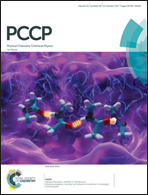Exploration of the forbidden regions of the Ramachandran plot (ϕ-ψ) with QTAIM†
Abstract
A new QTAIM interpretation of the Ramachandran plot is formulated from the most and least facile eigenvectors of the second-derivative matrix of the electron density with a set of 29 magainin-2 peptide conformers. The presence of QTAIM eigenvectors associated with the most and least preferred directions of electronic charge density explained the role of hydrogen bonding, H⋯H contacts and the glycine amino acid monomer in peptide folding. The highest degree of occupation of the QTAIM interpreted Ramachandran plot was found for the glycine amino acid monomer compared with the remaining backbone peptide bonds. The mobility of the QTAIM eigenvectors of the glycine amino acid monomer was higher than for the other amino acids and was comparable to that of the hydrogen bonding, explaining the flexibility of the magainin-2 backbone. We experimented with a variety of hybrid QTAIM–Ramachandran plots to highlight and explain why the glycine amino acid monomer largely occupies the ‘forbidden’ region on the Ramachandran plot. In addition, the new hybrid QTAIM–Ramachandran plots contained recognizable regions that can be associated with concepts familiar from the conventional Ramachandran plot whilst retaining the character of the QTAIM most and least preferred regions.



 Please wait while we load your content...
Please wait while we load your content...